Abstract
BACKGROUND:
A meta-analysis of different kinds of studies was performed to assess outcomes of laparoscopic versus open appendectomy in obese patients.
MATERIALS AND METHODS:
Retrospective and prospective studies enrolling patients with a body mass index greater than 30 kg/m2 were included. Primary outcomes were days of hospital stay, surgical procedure duration, and overall post-operative complication rate. Secondary outcomes were wound infection and intra-abdominal abscesses formation rate, hospital charges.
RESULTS:
Laparoscopic appendectomy showed to be significantly associated with lower wound infection (P < 0.001) and post-operative complication rate (P < 0.001). Surgical time was considered as a hallmark of technical challenge and resulted diminished in the laparoscopic group (P = 0.018). Although not clinically relevant per se, the statistically significant shorter hospital stay (P < 0.001) was probably the reason of decreased hospital charges (P < 0.001). Intra-abdominal abscesses formation rate was higher in the open appendectomy group (P = 0.058), although slightly above the statistical significance threshold.
CONCLUSION:
Laparoscopic approach seemed to show relevant advantages compared to open appendectomy, but a large prospective trial is necessary to collect high quality data and investigate long-term outcomes.
Keywords: Acute appendicitis, laparoscopic appendectomy, obesity, open appendectomy
INTRODUCTION
Appendectomy is one of the most common emergency surgery procedures. Despite a growing body of literature comparing results of laparoscopic and open approaches, data has revealed inconclusive and often contradictory. According to a Cochrane review published by Sauerland et al.,[1] laparoscopy does not show relevant advantages compared to open appendectomy, therefore indication should be limited to young women and obese patients. Evidence supporting this theory was based on retrospective studies,[2,3] administrative databases studies[4,5] and prospective trials with limited populations,[6,7] therefore cannot be considered solid enough to set laparoscopy as the gold standard procedure for obese patients affected by acute appendicitis. Since obesity represents a widespread condition in western societies, we performed a meta-analysis of different kinds of studies comparing open and laparoscopic appendectomy to pool and analyze a large quantity of data regarding the issue.
MATERIALS AND METHODS
Prospective and retrospective studies comparing outcomes of open appendectomy versus laparoscopic appendectomy were sought through PubMed/MedLine, Embase and Cochrane database using the key-words “laparoscopy,” “appendectomy,” “obese” in combination with Boolean operators to obtain papers simultaneously containing all of the search terms. Results were complemented with manual selection of articles listed in bibliographies. Evaluation and appraisal of papers were independently performed by the authors according to pre-established criteria. Conflicts were solved by consensus. Our study was carried out in accordance with the meta-analysis of observational studies in epidemiology guidelines.[8] No restrictions regarding publication date, status, language and population numerosity were applied.
At first level of filtering, titles and abstracts were analyzed to identify papers concerning the subject of our inquiry. Only studies involving patients with a body mass index (BMI) greater than 30 kg/m2 were considered eligible, according to the definition of obesity provided by World Health Organization and American Obesity Association guidelines.[9] Administrative databases based studies[4,5,10] included patients hospitalized with a diagnosis of appendicitis who underwent appendectomy identified at discharge with International Classification of Disease 9th revision (ICD-9) appendectomy codes 540 (acute appendicitis), 540.0 (acute appendicitis with generalized peritonitis), 540.1 (acute appendicitis with peritoneal abscess), 540.9 (acute appendicitis without peritonitis) and ICD-9 diagnosis codes of obesity (278.00), morbid obesity (278.01).
Statistical analysis was performed with comprehensive meta-analysis version 2.0. Odds ratios (OR) were calculated (95% confidence intervals [CI]) for discrete variables, whereas weighted mean differences (95% [CI]) were estimated for continuous variables. Effect sizes were calculated for each outcome using DerSimonian and Laird random effects model.[11] Heterogeneity was assessed with the Cochran Q-test (significant if P < 0.05) and influence of heterogeneity on OR value with I2 test. Results were presented in a forest plot. Publication bias was evaluated with Begg test[12] and represented on funnel plots; papers at high-risk of bias were excluded from the analysis.
Primary outcomes were days of hospital stay, surgical procedure time and post-operative complication rate. Secondary outcomes were wound infection and intra-abdominal abscesses formation rate, hospital charges. Since laparoscopic appendectomy to open appendectomy conversion rate was not always available, data were treated as an intention-to-treat analysis: Values regarding converted laparoscopic appendectomies were pooled with those of laparoscopic procedures.
RESULTS
Search resulted in 11 papers comparing outcomes of open versus laparoscopic appendectomy in obese patients. Two papers[7,13] were discarded as the BMI cut-off for patient selection was lower than 30 kg/m2. Papers published by Knott et al.,[14] and Kutasy et al.,[15] were discarded respectively because focusing on the single site laparoscopy in non-perforated appendicitis and extremely obese children. Another paper[16] was discarded since cases of converted laparoscopies had been excluded from statistical evaluation, whereas data in all other articles had been treated as an intention-to-treat analysis. Although[2] met eligibility criteria, it presented no usable data. Five papers were finally included[3,4,5,6,10] in our meta-analysis, resulting in a pooled population of 57,900 patients, 37,778 undergoing laparoscopic and 20,122 undergoing open appendectomy [Figure 1]. Table 1 summarizes patient and outcome data, Table 2 studies characteristics. Results of our meta-analysis are reported on Table 3.
Figure 1.
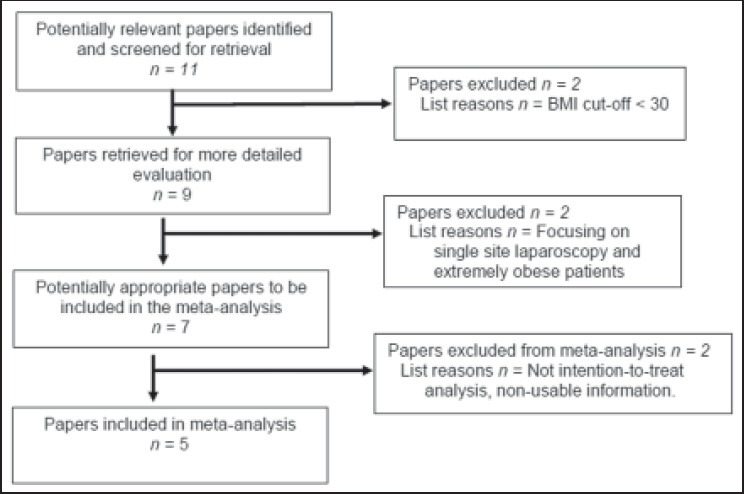
Flow chart of paper selection
Table 1.
Patient and outcome data
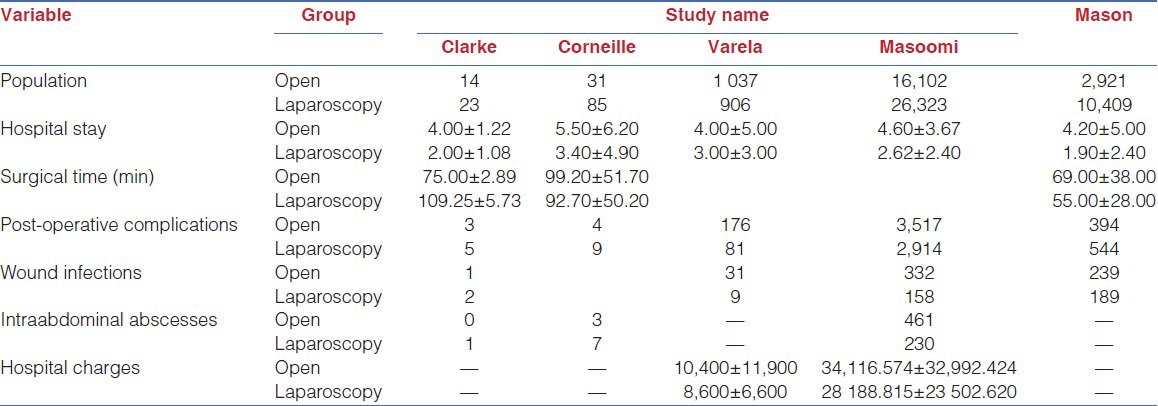
Table 2.
Studies characteristicts

Table 3.
Results
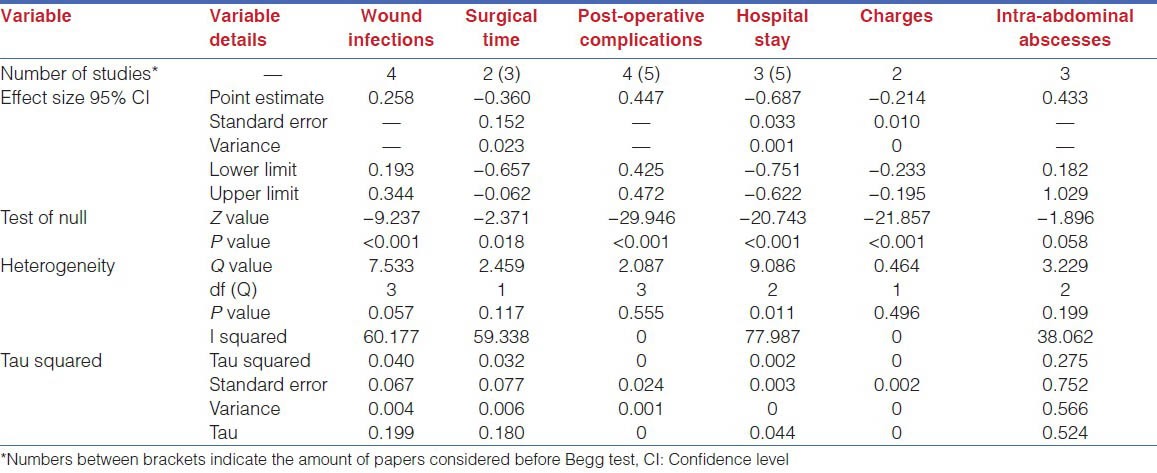
Primary Outcomes
Data regarding hospital stay [Figure 2] was available for all eligible studies.[5,6] were excluded because they were at high-risk of bias [Figure 2b]. Hospital stay resulted significantly lower in patients undergoing laparoscopic appendectomy (standard difference in means = −0.687; CI [−0.751; −0.622]; P < 0.001). Heterogeneity was present (Q = 9.086; P = 0.011; I2 = 77.987%).
Figure 2.
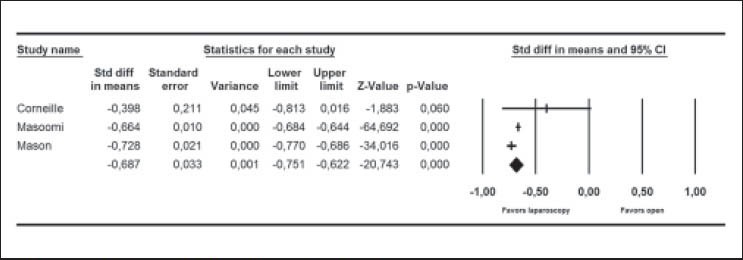
Forest plot of hospital stay
Figure 2b.
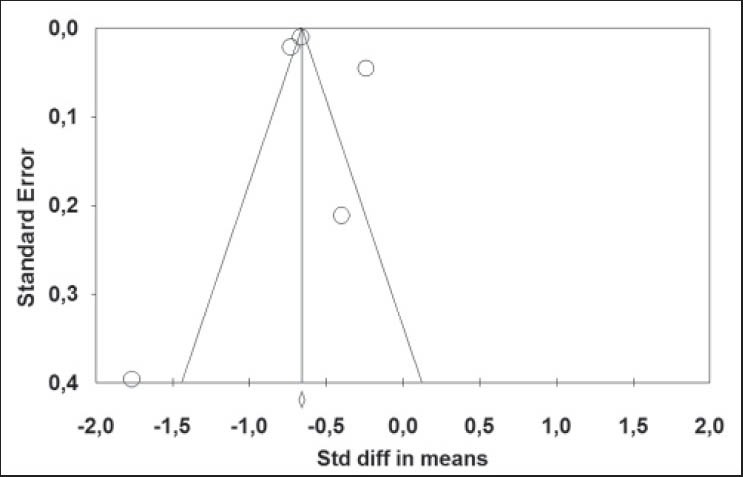
Funnel plot of hospital stay
Data regarding surgical time [Figure 3] was available for three studies, but[6] was excluded due to high-risk of bias [Figure 3b]. Surgical time resulted significantly lower for laparoscopic appendectomies (standard difference in means = −0.360; CI [−0.657; −0.062]; P = 0.018). Heterogeneity was not present (Q = 2.459; P = 0.117; I2 = 59.338%).
Figure 3.
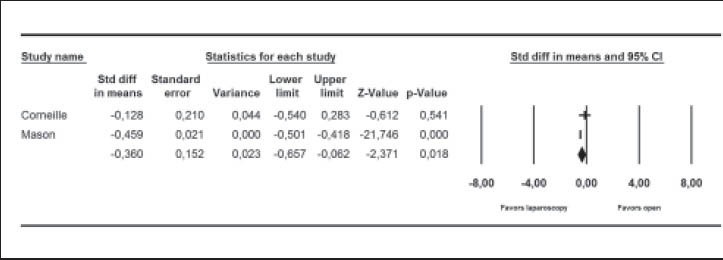
Forest plot of surgical time
Figure 3b.

Funnel plot of surgical time
Data regarding post-operative complication rate [Figure 4] was available for all included studies.[10] was discarded because it resulted to be biased at Begg test [Figure 4b]. The laparoscopic appendectomy group showed a significant decrease of post-operative complications rate (OR = 0.447; CI [0.425; 0.472]; P < 0.001). Heterogeneity was not present (Q = 2.087; P = 0.555; I2 = 0%).
Figure 4.

Forest plot of post-operative complication rate
Figure 4b.
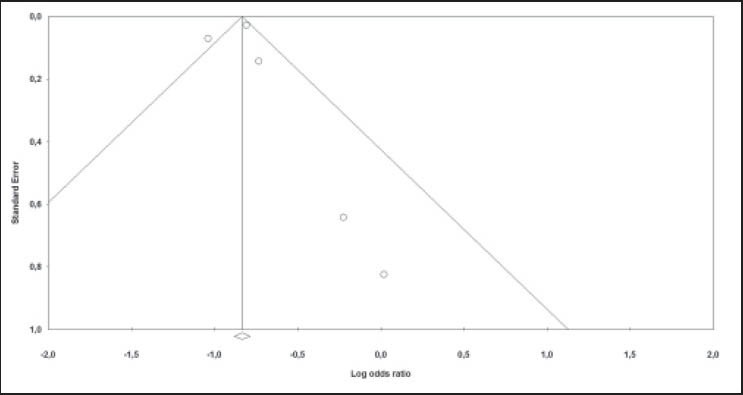
Funnel plot of post-operative complication rate
Secondary Outcomes
Wound infection rate [Figure 5] was available for all the included studies, but[3] was excluded because data were available for wound complications, but not specifically for wound infections. Wound infection rate resulted significantly lower for the laparoscopic appendectomy group (OR = 0.258; CI [0.193; 0.344]; P < 0.001). Heterogeneity was not present (Q = 7.533; P = 0.057; I2 = 60.177%).
Figure 5.
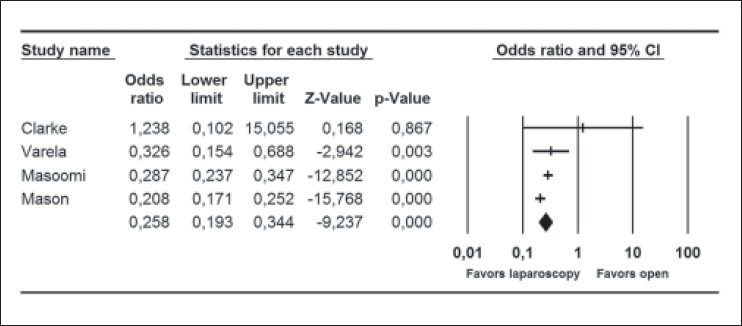
Forest plot of wound infection rate
Intra-abdominal abscess formation rate [Figure 6] was available for three studies. This variable resulted only slightly above statistical significance (OR = 0.433; CI [0.182; 1.029]; P = 0.058). Heterogeneity was not present (Q = 3.229; P = 0.199; I2= 38.062%).
Figure 6.
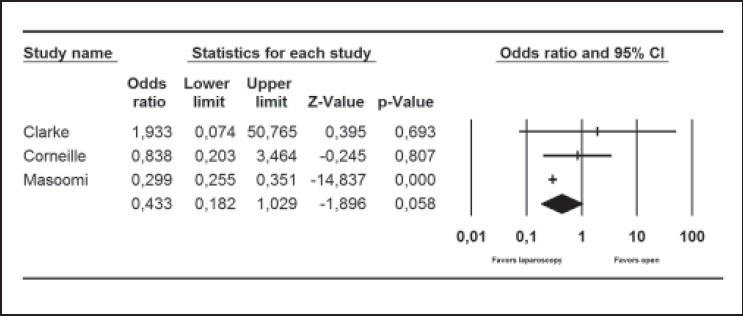
Forest plot of intra-abdominal abscesses formation rate
Hospital charges values [Figure 7] were available for three studies.[3] was not accounted because standard deviations were not reported. There was a significant reduction in the laparoscopic appendectomy group (standard difference in means = −0.214; CI [−0.233; −0.195]; P < 0.001). Publication bias could not be calculated. Heterogeneity was not present (Q = 0.464; P = 0.496; I2= 0%).
Figure 7.
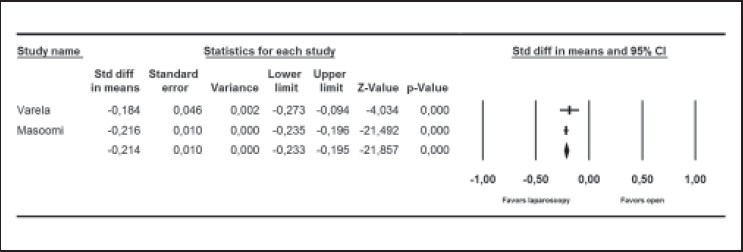
Forest plot of hospital charges
DISCUSSION
Obesity is a widespread medical condition in western societies and affects a great percentage of patients undergoing appendectomy. Anecdotal belief that laparoscopic appendectomy should be the procedure of choice in obese patients stands on the fact that the increased wall thickness poses an additional technical challenge during open appendectomy limiting hand movements and visual scope. Recently, published papers have placed more hard evidence favoring laparoscopic approach. Our meta-analysis aimed to pool and summarize different quality levels data regarding the issue.
The statistically significant reduction of hospital stay (P < 0.001) observed for patients undergoing laparoscopic appendectomy is not clinically relevant per se, but had a favorable impact on the hospital charges, for which a significant decrease was found (P < 0.001). Nonetheless, faster recovery and precocious return to productivity cannot be directly deduced from shorter hospital stay, because such variables are related to personal attitudes and job profile. Hospital charges were calculated on the basis of records stored in two large administrative database[4,5] and the pooled effect size probably underlies that the higher cost of laparoscopic instruments is counterbalanced by decreased hospital stay and therefore by reduced hospital charges.
Surgical time was considered as a hallmark of technical challenge related to surgical procedure. Clarke et al.,[6] reported a markedly elevated value for the laparoscopic appendectomy group, far beyond those mentioned in other papers. Such study was consequently excluded from our analysis for being at high-risk of bias after evaluation with Begg test. In a previously published meta-analysis, Markar et al.,[17] investigated surgical time based on data available in[3,6,7] and detected no significant difference between laparoscopic and open appendectomy, but this finding was probably biased by[6] Our study demonstrated instead a significant decrease of surgical time in the laparoscopic appendectomy group (P = 0.018).
Intra-abdominal abscesses formation rate was lower in the laparoscopic group, although slightly above the statistical significance threshold (P = 0.058), suggesting that laparoscopy is not associated with higher risk of intra-abdominal abscesses formation in obese patients. The study that mostly contributed to determine the effect size for this outcome was conducted by Masoomi et al.,[4] who reported a lower intra-abdominal formation rate in the laparoscopic appendectomy group and concluded that abdominal abscess fear should not be a reason to avoid laparoscopy. Pooled wound infection rate was significantly higher in the open appendectomy group (P < 0.001), consistently with findings reported on all examined papers. The association between obesity and diabetes mellitus is well-established, therefore reducing wound infection rate is particularly important due to diabetes related comorbidities. Wound infection could in fact prolong hospital stay, increase hospital charges and lead to serious complications especially in patients burdened by comorbidities. Post-operative complications definition differed to some extent among eligible papers and included urinary tract infection, pneumonia, acute renal failure, respiratory failure, myocardial infarction, deep vein thrombosis, pulmonary embolism, ileus, peripheral nerve damage, sepsis. After exclusion of a paper at high-risk of bias,[16] there was a significant decrease of post-operative complications in the laparoscopic appendectomy group (P < 0.001).
Masoomi et al.,[4] and Mason et al.,[10] showed results for aggregate and risk-adjusted outcomes with respect to demographic characteristics and comorbidities. Indications favoring laparoscopic appendectomy became more apparent after stratification of patients according to increasing BMI in either aggregate or matched populations. Mason et al.,[10] showed that overall morbidity was significantly better in the laparoscopic appendectomy group for both complicated and uncomplicated appendicitis and increasing BMI was associated with augmented morbidity in the open appendectomy group. The risk of post-operative complications after open appendectomy and BMI values showed a solid increase. On the other hand, patient groups undergoing laparoscopy with increasing BMI showed only a modest and non-significant increase in post-operative complication rate. After risk adjustment, non-wound related complications were similar irrespective of surgical technique, suggesting that the advantages of laparoscopic appendectomy in obese patients are mostly due to wound related complications.
The limitations of our meta-analysis are related to the non-prospective, non-randomized nature of the included studies and to the different ways data were collected in such series. The only prospective trial[6] presented a small sample size and scarcely concurred to determine effect sizes. In addition, population was not stratified according to clinical parameters such as severity of appendicitis, duration of symptoms, and associated comorbidities, which may be highly relevant in selecting the operative approach for non-randomized series and for affecting many of the outcome measures, such as wound infection, abscess, prolonged operative time, and costs. Due to data source limitations, the impact of surgical experience on procedure-related complications could not be assessed. A study[4] enrolling patients on the basis of ICD-9 discharge codes and not on actual BMIs may have over-included people not really fulfilling the definition of obesity. Even if such was the case, indications favoring laparoscopy remained well apparent. Finally, retrospective comparative studies lack long-term follow-up; therefore, complications such as intra-abdominal adherence, bowel obstruction and incisional hernias were not recorded.
CONCLUSIONS
Laparoscopic approach seemed to show relevant advantages compared to open appendectomy, but a large prospective trial is necessary to collect high quality data and investigate long-term outcomes.
Footnotes
Source of Support: Nil
Conflict of Interest: None declared.
REFERENCES
- 1.Sauerland S, Jaschinski T, Neugebauer EA. Laparoscopic versus open surgery for suspected appendicitis. Cochrane Database Syst Rev. 2010;10:CD001546. doi: 10.1002/14651858.CD001546.pub3. [DOI] [PubMed] [Google Scholar]
- 2.Towfigh S, Chen F, Katkhouda N, Kelso R, Sohn H, Berne TV, et al. Obesity should not influence the management of appendicitis. Surg Endosc. 2008;22:2601–5. doi: 10.1007/s00464-008-9847-6. [DOI] [PubMed] [Google Scholar]
- 3.Corneille MG, Steigelman MB, Myers JG, Jundt J, Dent DL, Lopez PP, et al. Laparoscopic appendectomy is superior to open appendectomy in obese patients. Am J Surg. 2007;194:877–80. doi: 10.1016/j.amjsurg.2007.08.043. [DOI] [PubMed] [Google Scholar]
- 4.Masoomi H, Nguyen NT, Dolich MO, Wikholm L, Naderi N, Mills S, et al. Comparison of laparoscopic versus open appendectomy for acute nonperforated and perforated appendicitis in the obese population. Am J Surg. 2011;202:733–8. doi: 10.1016/j.amjsurg.2011.06.034. [DOI] [PubMed] [Google Scholar]
- 5.Varela JE, Hinojosa MW, Nguyen NT. Laparoscopy should be the approach of choice for acute appendicitis in the morbidly obese. Am J Surg. 2008;196:218–22. doi: 10.1016/j.amjsurg.2007.08.067. [DOI] [PubMed] [Google Scholar]
- 6.Clarke T, Katkhouda N, Mason RJ, Cheng BC, Olasky J, Sohn HJ, et al. Laparoscopic versus open appendectomy for the obese patient: A subset analysis from a prospective, randomized, double-blind study. Surg Endosc. 2011;25:1276–80. doi: 10.1007/s00464-010-1359-5. [DOI] [PubMed] [Google Scholar]
- 7.Enochsson L, Hellberg A, Rudberg C, Fenyö G, Gudbjartson T, Kullman E, et al. Laparoscopic vs open appendectomy in overweight patients. Surg Endosc. 2001;15:387–92. doi: 10.1007/s004640000334. [DOI] [PubMed] [Google Scholar]
- 8.Stroup DF, Berlin JA, Morton SC, Olkin I, Williamson GD, Rennie D, et al. Meta-analysis of observational studies in epidemiology: A proposal for reporting. Meta-analysis Of Observational Studies in Epidemiology (MOOSE) group. JAMA. 2000;283:2008–12. doi: 10.1001/jama.283.15.2008. [DOI] [PubMed] [Google Scholar]
- 9.American Obesity Association. AOA Fact sheets. [Accessed May, 20, 2013]. Available from http://www.obesity.org/resources-for/what-is-obesity.htm .
- 10.Mason RJ, Moazzez A, Moroney JR, Katkhouda N. Laparoscopic vs open appendectomy in obese patients: Outcomes using the American College of Surgeons National Surgical Quality Improvement Program database. J Am Coll Surg. 2012;215:88–99. doi: 10.1016/j.jamcollsurg.2012.03.012. [DOI] [PubMed] [Google Scholar]
- 11.Begg CB, Mazumdar M. Operating characteristics of a rank correlation test for publication bias. Biometrics. 1994;50:1088–101. [PubMed] [Google Scholar]
- 12.DerSimonian R, Laird N. Meta-analysis in clinical trials. Control Clin Trials. 1986;7:177–88. doi: 10.1016/0197-2456(86)90046-2. [DOI] [PubMed] [Google Scholar]
- 13.Ricca R, Schneider JJ, Brar H, Lucha PA. Laparoscopic appendectomy in patients with a body mass index of 25 or greater: Results of a double blind, prospective, randomized trial. JSLS. 2007;11:54–8. [PMC free article] [PubMed] [Google Scholar]
- 14.Knott EM, Gasior AC, Holcomb GW, 3rd, Ostlie DJ, St Peter SD. Impact of body habitus on single-site laparoscopic appendectomy for nonperforated appendicitis: Subset analysis from a prospective, randomized trial. J Laparoendosc Adv Surg Tech A. 2012;22:404–7. doi: 10.1089/lap.2012.0056. [DOI] [PubMed] [Google Scholar]
- 15.Kutasy B, Hunziker M, Laxamanadass G, Puri P. Laparoscopic appendectomy is associated with lower morbidity in extremely obese children. Pediatr Surg Int. 2011;27:533–6. doi: 10.1007/s00383-010-2825-9. [DOI] [PubMed] [Google Scholar]
- 16.Tan-Tam C, Yorke E, Wasdell M, Barcan C, Konkin D, Blair P. The benefits of laparoscopic appendectomies in obese patients. Am J Surg. 2012;203:609–12. doi: 10.1016/j.amjsurg.2012.01.007. [DOI] [PubMed] [Google Scholar]
- 17.Markar SR, Venkat-Raman V, Ho A, Karthikesalingam A, Kinross J, Evans J, et al. Laparoscopic versus open appendicectomy in obese patients. Int J Surg. 2011;9:451–5. doi: 10.1016/j.ijsu.2011.06.005. [DOI] [PubMed] [Google Scholar]


